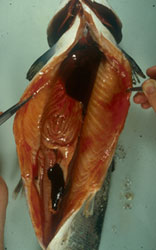Diseases of finfish
Viral diseases—Infectious salmon anaemia
CLICK ON IMAGE TO ENLARGE

Source: T Poppe
Signs of disease
Important: animals with disease may show one or more of the signs below, but disease may still be present in the absence of any signs.
Disease signs at the farm level
- mortality of up to 90%
Disease signs at the tank and pond level
- lethargy
- fish congregate in the upper water levels
- fish gasp at the surface
- inappetence
Clinical signs of disease in an infected animal
- pale gills
- ascites (swollen abdomen from accumulated fluid)
- bleeding eyes and fin rot are also common
- ecchymotic (bruise-like) skin haemorrhages may be present
Gross signs of disease in an infected animal
- liver and spleen are swollen and dark (early sign)
- pinpoint haemorrhages in internal fat
- blood in intestines
- haemorrhaging of the liver
- pale heart
Disease agent
Infectious salmon anaemia (ISA) virus is consistent with those of the Orthomyxoviridae family of viruses.
Host range
The only species seen to show clinical signs of ISA is the Atlantic salmon (Salmo salar).
Species known to be naturally asymptomatic carriers:
brown trout* (Salmo trutta) - least susceptible
coho trout* (Oncorhynchus kisutch)
rainbow trout* (Oncorhynchus mykiss)
Species shown experimentally to be asymptomatic carriers include:
Atlantic herring (Clupea harengus)
salmon louse (Lepeophtheirus salmonis)
* naturally susceptible (other species have been shown to be experimentally susceptible)
Presence in Asia–Pacific
EXOTIC — has not been officially reported in the Asia–Pacific region under the NACA–FAO–OIE quarterly aquatic animal disease reporting program.
Epidemiology
- ISA occurs in spring and early summer, at water temperatures from 3°C to above 15°C.
- Mortality varies up to 90%, and may occur over a prolonged period, not necessarily as acute outbreaks.
- Spread of the disease has occurred with the movement of live juvenile salmonids from fish farm to fish farm and with the discharge of organic waste from fish processing plants into the marine environment.
- Natural outbreaks seem to occur only in salmonids exposed to seawater.
- ISA has been the subject of extensive eradication campaigns in several countries, such as Scotland, which has since declared itself free from the disease.
- It appears that stress caused by treatment against salmon lice, cestodes or infectious diseases may predispose salmon to outbreaks of ISA two to three weeks later.
Differential diagnosis
The differential diagnostic table and the list of similar diseases appearing at the bottom of each disease page refer only to the diseases covered by this field guide. Gross signs observed might well be representative of a wider range of diseases not included here. Therefore, these diagnostic aids should not be read as a guide to a definitive diagnosis, but rather as a tool to help identify the listed diseases that most closely account for the gross signs.
Similar diseases
Infectious pancreatic necrosis, viral haemorrhagic septicaemia, infectious haematopoietic necrosis
Sample collection
Because of uncertainty in differentiating diseases using only gross signs, and because some aquatic animal disease agents might pose a risk to humans, you should not try to collect samples unless you have been trained. Instead, you should phone your national hotline number and report your observations. If samples have to be collected, the agency taking the call will advise you on what you need to do. Local or district fisheries/veterinary authorities could advise you on sampling.
Emergency disease hotline
For your national emergency disease hotline number, see Whom to contact if you suspect a disease.
Further reading
http://www.oie.int/aac/eng/cards/en_diseasecard.htm
The currently accepted procedures for a conclusive diagnosis of ISA are summarised at http://www.oie.int/eng/normes/fmanual/A_00026.htm
These hyperlinks were correct and functioning at the time of publication.

